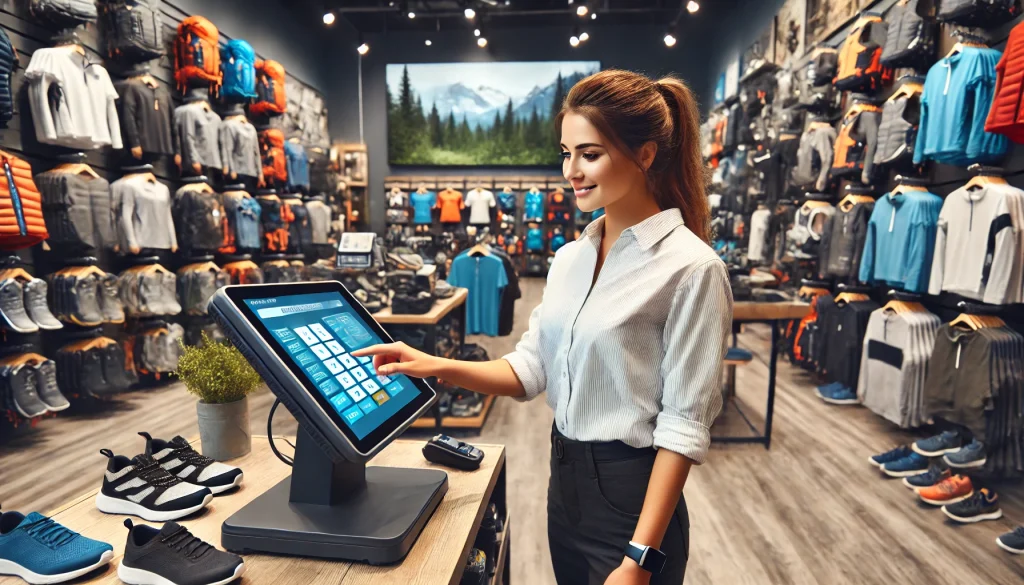Sports and outdoor equipment stores cater to a wide range of customers, from casual enthusiasts to serious athletes. Managing such a diverse inventory while ensuring an excellent customer experience can be challenging. A Point of Sale (POS) system tailored to the needs of sports and outdoor equipment stores can streamline operations, enhance customer service, and boost profitability. This guide will walk you through the essential steps for installing, training, and optimizing a POS system specifically designed for sports and outdoor equipment stores.
1. The Importance of a Specialized POS System for Sports & Outdoor Equipment Stores
A specialized POS system for sports and outdoor equipment stores is essential for several reasons:
- Inventory Management: Track seasonal items, rental gear, and high-value equipment efficiently.
- Sales and Promotions: Manage discounts, loyalty programs, and special promotions tailored to sports enthusiasts.
- Customer Relationship Management (CRM): Build lasting relationships with customers by tracking their purchase history, preferences, and providing personalized recommendations.
- Integrated E-commerce: Offer an online shopping experience that syncs with your in-store inventory.
- Rental and Service Tracking: Manage rentals, repairs, and servicing of equipment easily.
2. Installing the POS System
The installation of a POS system in your sports and outdoor equipment store requires careful planning and execution:
a. Needs Assessment:
- Determine the specific needs of your store. Consider the types of products you sell (e.g., clothing, gear, high-end equipment), the volume of inventory, and whether you offer rentals or services.
b. Hardware Requirements:
- Identify the hardware you need, such as:
- POS terminals with touchscreen interfaces
- Barcode scanners for quick checkout
- Receipt printers
- Mobile POS devices for outdoor sales events
- Digital displays for showcasing promotions
c. Software Installation:
- Install POS software that offers robust inventory management, CRM, and integration with e-commerce platforms. Ensure it can handle multi-store operations if you have more than one location.
d. Inventory Setup:
- Upload your product catalog, categorize items, and set up inventory tracking. Include information on suppliers, stock levels, and reordering thresholds.
e. Data Integration:
- Integrate the POS system with existing software for accounting, CRM, and e-commerce. If you offer rentals, ensure the system can track rental durations, deposits, and returns.
f. Testing and Calibration:
- Before going live, test all aspects of the system, including sales transactions, inventory updates, and reporting functions.
3. Staff Training
Proper training is essential to ensure your team can fully utilize the POS system’s features:
a. Basic Training:
- Train your staff on essential functions like processing sales, returns, and rentals. Ensure they are comfortable using the system’s interface and handling customer inquiries.
b. Specialized Training:
- Offer additional training for team members involved in inventory management, e-commerce, or service tracking. This might include managing product orders, setting up promotions, or handling online sales.
c. Rental and Service Management:
- Train staff on the specific processes for managing equipment rentals, including checking out gear, tracking rental periods, and processing returns. Additionally, provide training on managing service orders for equipment repairs or maintenance.
d. Ongoing Support and Updates:
- Ensure that your POS provider offers ongoing training and support. This is crucial for keeping up with system updates or new features.
4. Leveraging the POS System for Better Sales and Customer Engagement
Your POS system can do more than just process transactions. Use it as a tool for improving sales and customer engagement:
a. Inventory Optimization:
- Use the reporting features to identify top-selling products, slow-moving items, and seasonal trends. Adjust your stock levels accordingly to ensure you always have the right products available.
b. Promotions and Loyalty Programs:
- Create targeted promotions based on customer data. For example, offer discounts on winter gear at the end of the season or create loyalty programs that reward repeat customers with exclusive deals.
c. Customer Insights:
- Leverage the CRM to track customer preferences and purchase history. Use this data to offer personalized recommendations, both in-store and through email marketing.
d. E-commerce Integration:
- If you have an online store, ensure that it’s fully integrated with your POS system. This allows you to sync inventory, manage orders, and offer seamless shopping experiences across all channels.
e. Event Management:
- If you host outdoor events or pop-up sales, use mobile POS devices to manage transactions on the go. This ensures that you never miss a sale, even outside the store.
5. Conclusion
Implementing a specialized POS system in your sports and outdoor equipment store can revolutionize the way you manage your business. From streamlined operations to enhanced customer engagement, the benefits are significant. By following the steps outlined in this guide—installing the system correctly, training your staff, and leveraging the system’s features—you can ensure your store remains competitive and responsive to customer needs.
For more information or to get started with a customized POS system for your sports and outdoor equipment store, visit POSInventorySystem.com or call us at +1-800-434-9026. Our experts are ready to assist you in optimizing your business.

